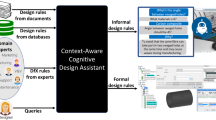Abstract
Contemporary product design based on 3D CAD tools aims at improved efficiency using integrated engineering environments with access to databases of existing designs, associated documents and enterprise resource planning. The ultimate goal of this work is to achieve design process improvements by applying state-of-the-art ILP systems for relational data mining of past designs, utilizing commonly agreed design ontologies as background knowledge. This paper demonstrates the utility of relational data mining for virtual engineering of product designs through the detection of frequent design patterns, enabled by the proposed baseline integration of hierarchical background knowledge (a CAD ontology) using sorted refinements.
Preview
Unable to display preview. Download preview PDF.
Similar content being viewed by others
References
Appice, A., Ceci, M., Lanca, A., Lisi, F.A., Malerba, D.: Discovery of spatial assocation rules in geo-referenced census data: A relational mining approach. Intelligent Data Analysis 7, 541–566 (2003)
Ceci, M., Appice, A.: Spatial Associative Classification: Propositional vs. Structural approach. In: Proceedings of the ECML/PKDD 2004 Workshop on Mining Spatio temporal Data (2004)
Dehaspe, L., Toivonen, H.: Discovery of frequent DATALOG patterns. Data Mining and Knowledge Discovery 3(1), 7–36 (1999)
Dolšak, B., et al.: Finite element mesh design: An engineering domain for ILP application. In: Proc. of ILP 1994, GMD-Studien, vol. 237, pp. 305–320 (1994)
Donini, F.M., Lenzerini, et al.: AL-log: Integrating Datalog and Description Logics. Journal of Intelligent Information Systems 10(3), 227–252 (1998)
Frisch, A.: Sorted downward refinement: Building background knowledge into a refinement operator for ILP. In: Džeroski, S., Flach, P.A. (eds.) Inductive Logic Programming. LNCS (LNAI), vol. 1634, Springer, Heidelberg (1999)
King, R.D., et al.: Functional genomic hypothesis generation and experimentation by a robot scientist. Nature 427, 247–252 (2004)
Levy, A., Rousset, M.-C.: Combining Horn rules and description logics in CARIN. Artificial Intelligence 104, 165–209 (1998)
Lisi, F.A., Malerba, D.: Ideal Refinement of Descriptions in AL-Log. In: Horváth, T., Yamamoto, A. (eds.) ILP 2003. LNCS (LNAI), vol. 2835, pp. 215–232. Springer, Heidelberg (2003)
McGuinness, D.L., van Harmelen, F. (eds.): OWL Web Ontology Language Overview. W3C Recommendation (February 10, 2004) Available online at http://www.w3.org/TR/owl-features/
RDF Vocabulary Description Language 1.0: RDF Schema. W3C Recommendation ( February 10, 2004), available at http://www.w3.org/TR/rdf-schema/
Srinivasan, A.: The Aleph manual version 4 (2003) (June 7, 2006), available online at http://web.comlab.ox.ac.uk/oucl/research/areas/machlearn/Aleph/
Srinivasan, A., Muggleton, S., et al.: Theories for mutagenicity: A study in first-order and feature-based induction. Artificial Intelligence 85(1-2), 277–299 (1996)
Srinivasan, A., King, R.: Feature construction with ILP: A study of quantitative predictions of biological activity aided by structural attributes. In: ILP 1996. LNCS, vol. 1314, pp. 352–367. Springer, Heidelberg (1997)
Witten, I.H., Frank, E.: Data Mining: Practical machine learning tools and techniques, 2nd edn. Morgan Kaufmann, San Francisco (2005)
Železný, F., Lavrač, N.: Propositionalization-based relational subgroup discovery with RSD. Machine Learning 62, 33–63 (2006)
Author information
Authors and Affiliations
Editor information
Rights and permissions
Copyright information
© 2007 Springer-Verlag Berlin Heidelberg
About this paper
Cite this paper
Žáková, M. et al. (2007). Relational Data Mining Applied to Virtual Engineering of Product Designs. In: Muggleton, S., Otero, R., Tamaddoni-Nezhad, A. (eds) Inductive Logic Programming. ILP 2006. Lecture Notes in Computer Science(), vol 4455. Springer, Berlin, Heidelberg. https://doi.org/10.1007/978-3-540-73847-3_39
Download citation
DOI: https://doi.org/10.1007/978-3-540-73847-3_39
Publisher Name: Springer, Berlin, Heidelberg
Print ISBN: 978-3-540-73846-6
Online ISBN: 978-3-540-73847-3
eBook Packages: Computer ScienceComputer Science (R0)




